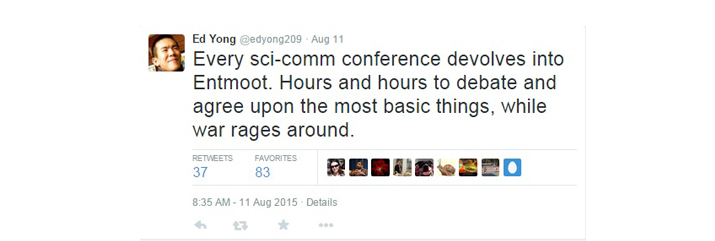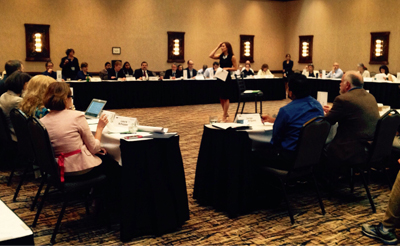 This guest post was written by Rick Borchelt, who participated in the Communicating Science for Policy Workshop held August 10–11, 2015, in Durham, North Carolina. The workshop was hosted by the Institute on Science for Global Policy and organized in cooperation with Sigma Xi, The Scientific Research Society.
This guest post was written by Rick Borchelt, who participated in the Communicating Science for Policy Workshop held August 10–11, 2015, in Durham, North Carolina. The workshop was hosted by the Institute on Science for Global Policy and organized in cooperation with Sigma Xi, The Scientific Research Society.
Veteran science blogger Ed Yong recently commented on live Twitter feeds originating from (yet another) conference on how to improve science communication:

Remarkably discerning for someone who wasn’t even in the room! I was in the room, as I often am for these kinds of conversations, and while the discussion is always passionate, and intense, and vibrant, it’s often (almost always) … um, kind of pointless. Here’s why.
The conversations among the scientists and a surprisingly large number of science communicators almost always start with a reinvention of the wheel — the premise that more science communication is good. Can’t argue with that generally, assuming the quality is up to par and care is taken to make sure it’s an accurate reflection of the science involved. But then the discussants almost always go a step beyond to assert that better science communication will lead to increased science literacy. And other magnificent good things.
Here’s where the conversation starts going off the tracks. Because there is not a shred of good data to support this assertion.
 In fact, there is little evidence that anything we have done as science communicators since the end of World War II has moved the needle one mark on the science literacy scale — we’ve poured lots of money in it and literacy hasn’t changed, we’ve gone through lean times with almost no funding and literacy hasn’t changed, science journalism has been in the catbird seat for a while and then in a tailspin for a decade and science literacy hasn’t changed, Bill Nye the Science Guy came and went on television and science literacy didn’t change, we’ve launched initiative after adult, informal science education initiative after initiative from NSF, NASA, NOAA and the rest of the known science funding universe and science literacy remains stubbornly low. And we continue to agonize over this.
In fact, there is little evidence that anything we have done as science communicators since the end of World War II has moved the needle one mark on the science literacy scale — we’ve poured lots of money in it and literacy hasn’t changed, we’ve gone through lean times with almost no funding and literacy hasn’t changed, science journalism has been in the catbird seat for a while and then in a tailspin for a decade and science literacy hasn’t changed, Bill Nye the Science Guy came and went on television and science literacy didn’t change, we’ve launched initiative after adult, informal science education initiative after initiative from NSF, NASA, NOAA and the rest of the known science funding universe and science literacy remains stubbornly low. And we continue to agonize over this.
What the data do support is that there is a minority — a large minority, granted, somewhere around 20 percent of the American public — that could be classified as “science attentive.” They seek out some kinds of science information proactively, most often on health-related matters. But the audience that we assume is there to read with joy and awe and optimism about the wonders of science writ large is, well … there isn’t one. Or at least there isn’t one large enough to write a check to do science writing or science communication on any kind of large scale. If willingness to pay for science content is any kind of indication, then adult Americans by and large would much rather watch Game of Thrones. Or Cait Jenner. Or soccer.
We can write great stories, film PSAs, upload YouTube videos, host Google hangouts and Reddit AMAs, and send legions of scientists out into museums and science cafes until the cows come home and they’ll still only be talking to a very small number of adults. And usually the same people, over and over and over again. Nothing we are doing as science communicators is recruiting new people into the ranks of the science attentive. Or improving science literacy.
For this, in our meetings and conferences we typically blame the audience. If only they were smarter or better educated to begin with, they would obviously want to pay more attention to science. If only they understood how critical a role scientists play in our everyday lives, they would pay more attention to what we do. If only they would stop paying attention to Kim Kardashian and watch more PBS, they would obviously want to pay more attention to science. And science literacy would skyrocket.
And once we’re done blaming the audience, we blame the media, albeit there aren’t really enough traditional science media around to blame anymore. Media hype science stories, especially medical ones, until people don’t know what to believe anymore. PR people at federal agencies and corporations spin stories to make their missions and their products more important or more credible than they are, and the media eat this pabulum up like marmalade on toast. Even though we are sure people actually want to see hard-hitting, scientifically based nature footage of calm sharks going about their business in murky surf, the media persist in showing us Shark Week and Sharknado. If they didn’t, people would be more scientifically literate.
And for good measure, we whip the scientists a little too, lest we be accused of favoritism. Scientists don’t understand how to talk to normal people. Scientists put the stink eye on any of their fraternity who deign to popularize science. Scientists have to be dragged kicking and screaming away from the bench to talk to the unwashed masses. Scientists need to be taught how to tell a story rather than recite a thesis.
These conversations are about 90 percent of the discussion at conferences on science communication — usually all but the last 15 minutes of a two-day talk-fest. Granted, there’s usually one evidence-based outlier invited in to talk social science findings, but that’s usually sandwiched somewhere between lunch and the time the first folks start heading for the door for an early airplane flight. Hence Ed’s Entmoot.
No productive recommendations can come from these discussions, because they are flawed from the get-go. We need to face the facts that science is a low-salience issue for most Americans, Kim Kardashian is more salient, and very little we can ever do is going to change that. Wishing will not make it so. A legion of Carl Sagans will not make it so. A 40-page Tuesday Science Times delivered to your doorstep or to your iPad every week will not make it so. A mandatory two-hour block of science programming every night on the CW channel will not make it so. Adult Americans pay attention to science only when they think it directly affects them, not when we think they should pay attention. And their minds, lives, and careers are generally packed with plenty of other stuff that they think is more important. In no universe I know of will science out-compete this other stuff.
The good news is, it’s been this way for three generations and the world has not come to an end. Federal science budgets, although every scientist will tell you we don’t have enough money ever to do enough science, are pretty robust. New technologies and innovations are rolling out of American universities and corporations every minute. The goose that lays the golden eggs of basic research that hatch into medical cures and energy supplies and the Higgs boson hasn’t run out of yolk yet.
The truth is, public science literacy is not now, nor has it ever been, the driving factor behind science budgets or national science policy. No national level election has ever turned on an issue of science. Grassroots action seldom translates into national science policy; policy is formulated as a compromise between different perspectives by different stakeholders at the policy table, and science is seldom dealt the cards that trump all other societal concerns.
So: We don’t know what kinds or quantities of science communication actually affect general scientific literacy. What little evidence we do have is that science communication and other informal science learning are at best of marginal value to boosting adult scientific literacy—way, way, way behind such factors as years of total educational attainment and number of college science classes taken. And even if there were better correlations between science communication and scientific literacy, we have no evidence at all that scientific literacy is connected even loosely with the quality of scientific decision making, science budgets, or science policy. And of course we lack any evidence that civilization as we know it will crumble the next time Dr. Oz hawks a vitamin supplement.
If I take issue with Ed Yong’s tweet — which provided a moment of levity and welcome self-reflection after two days of debate — it’s that there is no war raging except among our own ranks. There is no anti-science conspiracy, we haven’t become a nation of Luddites tossing our iPhones into the nearest dumpster, and we are in no danger of running out of adolescent geeks — male and female — ready to lead the next generation of scientists.
So why do I continue to engage in this discussion about how to do better science communication, raise scientific literacy, and improve science policy? It’s because they are all worthy goals in a democratic society in their own right, not as flagstones along a straight path toward the day that “scientific truth” is the arbiter of every policy outcome. Science will always need to jostle and spar with other parts of society to be heard, understood, and listened to — and even then won’t always prevail. But we owe it to ourselves to make sure that when we want to understand science, there is compelling and engaging science communication to inform us. When we want to engage in a policy or funding debate, we owe it to ourselves to have at our fingertips — if not already in our brain cells — the data and the perspectives to bring the issues into focus.
And when we want to watch Kim Kardashian instead of Neil deGrasse Tyson, well… that’s a choice a democratic society respects.
Rick Borchelt is communications director for science at the U.S. Department of Energy. He has enjoyed a 30-year career in federal — including Congressional, White House, and agency service — and university science writing, science communications, and science policy. He is a past president of the DC Science Writers Association and serves on the editorial board of the journal Science Communication.
Photo captions:
Top: A screen shot of Ed Yong's tweet.
Bottom: The Communicating Science for Policy Workshop included three speakers who debated their ideas with participants. Here, Liz Neeley, executive director of The Story Collider, shares her ideas about using narrative persuasion for ethical science communication.